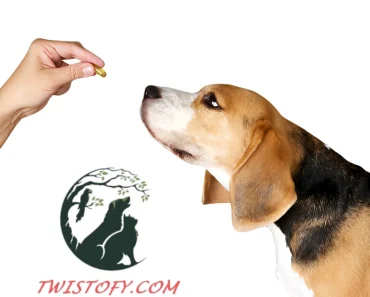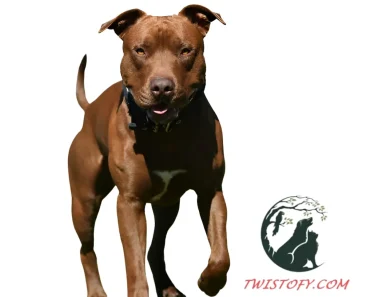Winter Wonders and Risks: Keeping Your Dog Safe During the Colder Months Winter dangers for dogs
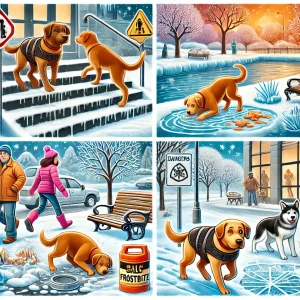
Winter dangers for dogs
Winter’s beauty can be enchanting, but it also hides risks for our four-legged friends. From slippery sidewalks to toxic antifreeze, keeping your dog safe requires a bit of extra care. Through my own experiences with dogs (and foster pups!), I’ve learned valuable lessons that I’m excited to shar.
15 Winter Dangers and How to Shield Your Dog
1. Antifreeze
Antifreeze is highly toxic to dogs, and its sweet taste makes it particularly appealing. Even the smallest amount can be life-threatening if consumed.
In our household, we’ve made it a rule to keep the dogs out of the garage whenever antifreeze is in use. We also clean up any spills immediately, a simple habit that provides us with peace of mind.
✅ Safety Tips:
- Store antifreeze securely and out of reach.
- Clean spills promptly.
- Opt for pet-safe antifreeze products when possible.
Look for labels indicating ethylene glycol or propylene glycol. While propylene glycol-based antifreeze is less toxic, it’s still harmful if ingested in large amounts.
Important: According to the Animal Poison Control Center, antifreeze poisoning occurs in three distinct stages. Being aware of these can help you respond quickly in an emergency.
2. Ice, Snow Melt, and Rock Salt
Many de-icing products, like rock salt, contain chemicals that can irritate your dog’s paws, causing dryness, cracking, or even burns. If ingested—whether from licking paws or eating residue—it can lead to stomach upset or toxicity.
After noticing irritation on my dogs’ paws from standard ice melt, we switched to a pet-safe alternative, like Safe Paw. It’s not only better for their paws but also kinder to our floors!
✅ Safety Tips:
- Use pet-safe ice melt on your property.
- Rinse or wipe your dog’s paws after walks, especially in heavily salted areas.
- Consider using dog booties or applying paw balm for extra protection.
3. Frostbite and Hypothermia
Prolonged exposure to extreme cold can result in frostbite or hypothermia for dogs. Warning signs include shivering, lethargy, and lifting their paws off the ground to avoid contact with the cold.
✅ Safety Tips:
- Limit outdoor time in freezing weather.
- Use dog coats or sweaters, especially for smaller or short-haired breeds.
- Monitor your dog closely for signs of cold stress.
Winter Hazards: How to Keep Your Dog Safe
Winter weather can be tough on our furry friends, but with a little extra care, you can ensure their safety and comfort during the colder months. Here are some common dangers and practical tips to protect your dog.
3. Frostbite and Hypothermia
My dogs love being outside and would stay out for hours if they could. However, as soon as I see them lifting their paws to avoid the cold, I know it’s time to bring them inside.
✅ Tips for Safety:
- Limit outdoor time in freezing temperatures.
- Dress short-haired breeds in coats or sweaters for warmth.
- Dry your dog off thoroughly after coming indoors.
4. Cracked and Bleeding Paws
Cold weather can dry out your dog’s paw pads, leading to cracks, irritation, and discomfort. Just like human skin, a dog’s paws need extra care in winter. I use paw balm regularly to keep their pads soft and healthy.
✅ Tips for Safety:
- Apply a dog-safe paw balm like Musher’s Secret to protect and moisturize their pads.
- Check their paws frequently for dryness, cracks, or injuries.
5. Fire Hazards
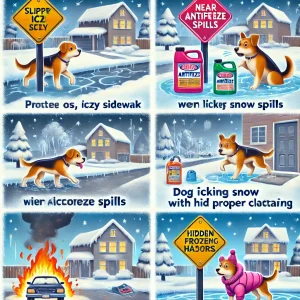
Winter dangers for dogs
Space heaters and fireplaces can be risky, especially for curious or energetic dogs. My dog, Wizard, loves running around my office and has knocked over my space heater several times. Luckily, it has a tip-over safety feature, but it’s a good reminder to use safe equipment.
✅ Tips for Safety:
- Use space heaters with automatic shut-off features.
- Keep cords and hot surfaces out of reach.
- Supervise your dog around open flames or heated equipment.
6. Frozen Lakes or Ponds
Frozen water is incredibly dangerous if the ice isn’t thick enough to support your dog. My dog, Bear, loves water in any form, but I would never let him near frozen ponds or lakes in the winter for fear he might fall in and struggle to get out.
✅ Tips for Safety:
- Always keep your dog on a leash near frozen water.
- Avoid letting them walk on ice, even if it looks solid.
7. Ice
Slippery ice is hazardous for both dogs and humans. Falls can lead to painful injuries or bruises that take weeks to heal. I’ve had my fair share of slips, and unfortunately, so have my dogs.
✅ Tips for Safety:
- Walk carefully on icy paths.
- Use pet-safe booties for added traction.
- Stick to salted or cleared walkways whenever possible. Winter dangers for dogs
8. Electrical Cords
Heater, holiday lights, and other electrical cords can be tempting for dogs to chew, posing risks of electrical shock. I’ll never forget the time a foster dog quietly chewed through a charging cord while I thought she was peacefully napping under my desk!
✅ Tips for Safety:
- Hide or secure cords, especially for curious chewers.
- Use cord protectors or covers for added safety.
- Keep your dog in a playpen or crate when you can’t supervise them. Winter dangers for dogs
9. Christmas Decorations
Holiday décor can be irresistible to dogs but also dangerous. Fragile ornaments, small decorations, and tinsel can cause injuries or blockages if ingested. Even poinsettias, while festive, are mildly toxic to dogs and cats.
Last year, Wizard tried to play with a ceramic village under the tree. This year, he managed to snag a plastic icicle ornament to chew on!
✅ Tips for Safety:
- Keep fragile decorations and tinsel out of reach.
- Supervise your dog around the Christmas tree.
- Avoid displaying toxic plants like poinsettias where your dog can access them. Winter dangers for dogs
Winter Hazards: Keeping Your Dog Safe and Happy
Winter brings unique challenges for our dogs, but with some precautions, you can ensure they stay safe and enjoy the season. Let’s explore more common dangers and how to prevent them.
10. Pesticides and Rodenticides
Rodenticides are highly toxic to dogs and should always be kept out of their reach.
Living in the countryside, we often deal with mice. Instead of rodenticides, we use traps in dog-free areas and a noise device in the garage to keep rodents away. Winter dangers for dogs
✅ Tips for Safety:
- Avoid rodenticides or choose non-toxic alternatives.
- Use traps and devices in locations inaccessible to your dog. Winter dangers for dogs
11. Holiday Foods
Winter celebrations often include treats that can be dangerous for dogs, such as chocolate, fatty foods, and alcohol. While we love including our dogs in holiday traditions, like a special Christmas dinner, we ensure their meals are dog-safe. Winter dangers for dogs
✅ Tips for Safety:
- Keep unsafe foods out of reach.
- Inform guests not to feed your dog anything without checking first.
- Offer your dog safe treats or meals specifically made for them. Winter dangers for dogs
12. Deep Snow Dangers
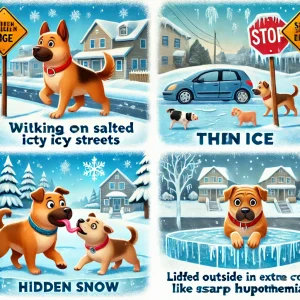
Winter dangers for dogs
Playing in deep snow can be fun for dogs, but it’s not without risks. Overexertion is common, especially for small or senior dogs. Snow can also hide hazards like sharp objects, holes, or frozen debris, which may cause injuries. Winter dangers for dogs
My dogs love bounding through snowdrifts, but I always keep a close eye on them to ensure they’re safe and don’t overdo it.
✅ Tips for Safety:
- Monitor your dog’s energy levels and take breaks during snowy play.
- Stick to well-traveled paths to avoid hidden dangers.
- Watch for signs of fatigue, such as slowing down or struggling to move.
13. Falling Icicles
Icicles are beautiful but dangerous. Sharp or heavy icicles can fall unexpectedly and cause serious injuries if your dog is underneath them. Winter dangers for dogs
✅ Tips for Safety:
- Avoid areas with overhead icicles, especially near doorways or the edges of roofs.
- Regularly inspect and safely remove large icicles from your home.
- Supervise your dog in areas with potential falling hazards.
Did You Know? Icicles form when heat escapes from your home, melting roof snow, which then refreezes as it drips. Proper insulation can help reduce their formation. Winter dangers for dogs
14. Fireplaces and Wood Stoves
While cozy and warm, fireplaces and wood stoves can be dangerous for curious dogs. Open flames, hot embers, and even the glass doors of a wood stove can cause burns. Additionally, firewood debris and ashes may irritate your dog’s skin or be accidentally ingested.
✅ Tips for Safety:
- Use a secure fireplace screen or gate to block access to open flames and hot surfaces.
- Teach your dog commands like “stay” or “leave it” to keep them away from the fireplace.
- Store firewood, matches, and tools in a safe place out of reach.
A little caution ensures everyone can enjoy a cozy fire safely. Winter dangers for dogs
15. Carbon Monoxide Poisoning
Carbon monoxide (CO) is a silent threat during winter. This invisible, odorless gas can accumulate in enclosed spaces, particularly when using heaters, fireplaces, or generators. Dogs are just as vulnerable to CO poisoning as humans and may show symptoms like lethargy, vomiting, or difficulty breathing. Winter dangers for dogs
✅ Tips for Safety:
- Ensure proper ventilation when using heating devices or generators.
- Install carbon monoxide detectors, especially near sleeping areas and where your dog spends most of their time.
- Never leave your dog in an idling car, as CO can build up quickly. Winter dangers for dogs
Winter Safety = Happy Dogs
With thoughtful preparation, winter can be a safe and enjoyable season for your dog. From choosing pet-safe products to keeping an eye on their energy levels, small precautions can prevent big problems and keep tails wagging all winter long. Winter dangers for dogs


